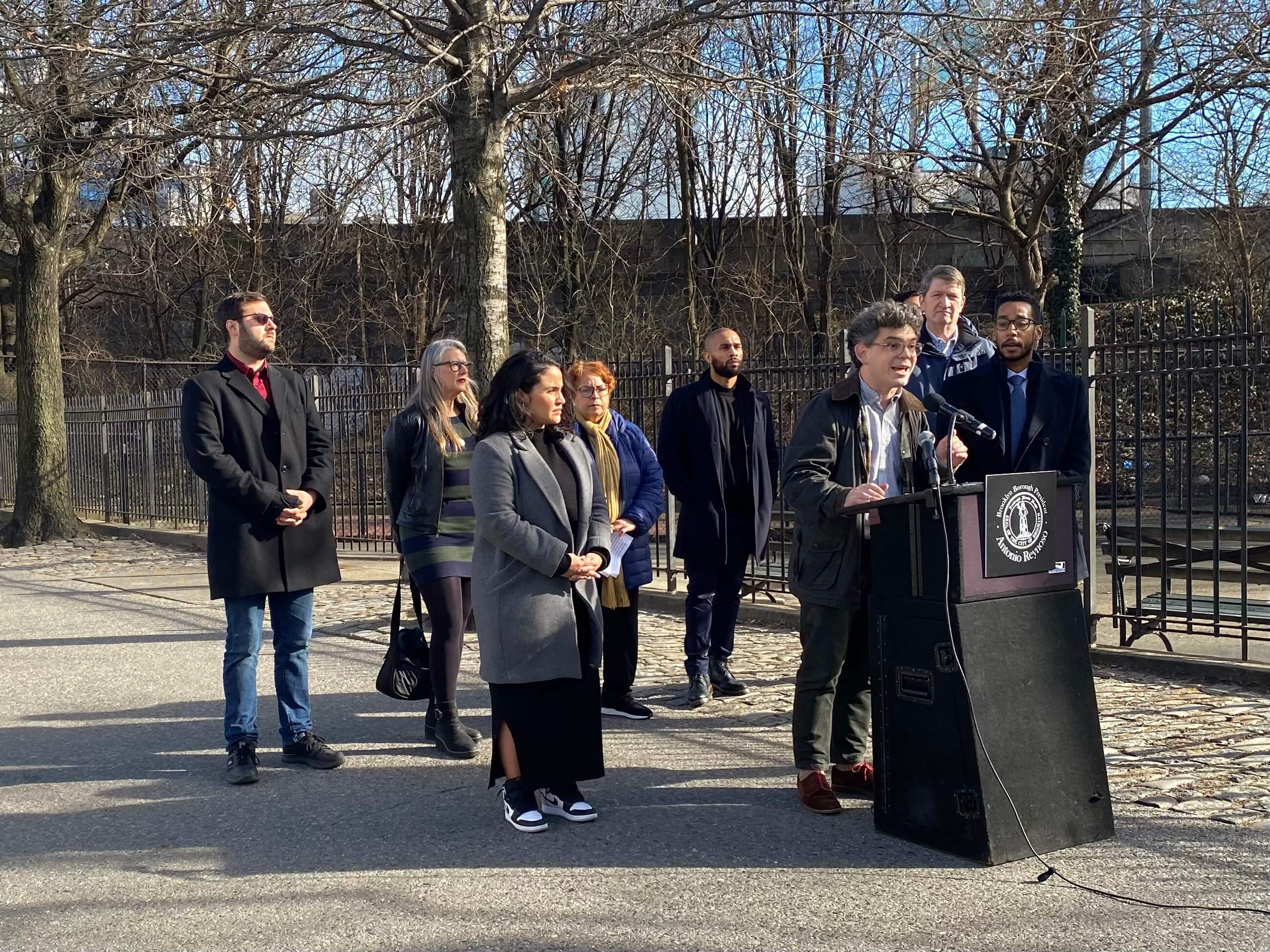Brooklyn Borough President Antonio Reynoso, Council Member Jennifer Gutiérrez, Council Member Lincoln Restler, representatives from the offices of Congresswoman Nydia Velázquez, and other leaders spoke about the Brooklyn Queens Expressway (BQE) outside of Jaime Campiz Playground in Williamsburg on February 13.
They condemned NY State for not working with the NYC Department of Transportation (DOT) to re-design the BQE in order to spare neighborhoods like Williamsburg, Red Hook, Bay Ridge, and more from the expressway’s fumes.
“If we miss this opportunity to address the harms of the past, make no mistake, New York State is to blame,” said Reynoso. “This is about environmental justice, this is about public health, and this is about equity for Black and Brown, Latino, and AAPI [Asian American Pacific Islander] New Yorkers who have carried the burden of the BQE for generations.
“By refusing to work with the City on a corridor-wide re-design, New York State is choosing to reinforce the inequities that were thrust upon our communities by Robert Moses. We won’t be collateral damage any longer. From Greenpoint to Brooklyn Heights to Bay Ridge, we are unified. This is our chance to deliver justice.”
In the 1940s and 1950s, urban planner Robert Moses designed the BQE to run through working-class neighborhoods. Brooklyn Heights was a wealthier neighborhood, and rather than having the BQE cut through it, the Promenade was built at the edge .
Though NY State owns most of the BQE, the City owns the Promenade. DOT has limited traffic there as a temporary solution while they try again to find a permanent one.
Reynoso and other politicians see this as an opportunity for the state to take advantage of federal infrastructure funds and change the design of the entire BQE to make it better for the neighborhoods it passes through.
“While there is an urgent effort to fix the crumbling cantilever in Brooklyn Heights by the NYC DOT, the NYS DOT has not committed to revisioning the highway’s State-owned portions to the north or south,” said Nydia Velazquez in a statement.
Some of the biggest concerns are the health risks posed by auto fumes. Lincoln Restler pointed to studies indicating higher asthma rates for people living near the BQE .
“If you walk up and down Marcy Ave., you will find people living on top of the BQE breathing in these horrible fumes each and every day. People are dying because of the BQE.”
Assemblymember Jo Anne Simon struck back at the State scapegoating.
“I know that people have expressed concern about the state’s lack of involvement but the state is more involved than I think the public sees,” the state legislator said. “Additionally, elected officials throughout the government at all different levels are talking to each other about the corridor. It’s complicated but we all share the same concerns and we all want to find a solution.”
There is also a political demand to pinch in BQE traffic by making it two lanes each way as it passes through the Heights. In a letter to US Transportation Secretary Pete Buttigieg, Simon supported the pinching. “Studies have consistently shown that increasing roadway capacity does not reduce congestion, but rather incentivizes roadway use and produces higher traffic volumes.”
Regardless of what supposed studies show, the incredible amount of traffic on Columbia St., Atlantic Ave., and Hicks St. since the BQE switched from six lanes to four seems to indicate otherwise. Those who rely on the BQE to commute certainly won’t be happy if the change to four lanes becomes permanent. Nor will residents of the Columbia Waterfront District who bear the brunt of the added street congestion.
“The traffic is certainly a concern and we’re waiting on DOT to improve signage in areas right off the BQE like Hicks St. and Columbia St.,” Simon said. “That wouldn’t solve the problem but it should help make a difference. I understand the frustration with the traffic because I live with it myself, but right now the priority is protecting the triple cantilever. If the triple cantilever falls off a cliff, we will be in for a world of hurt which is much worse than the increased traffic.”
It’s clear that something needs to be done about the BQE. What’s unclear is what exactly that is.









